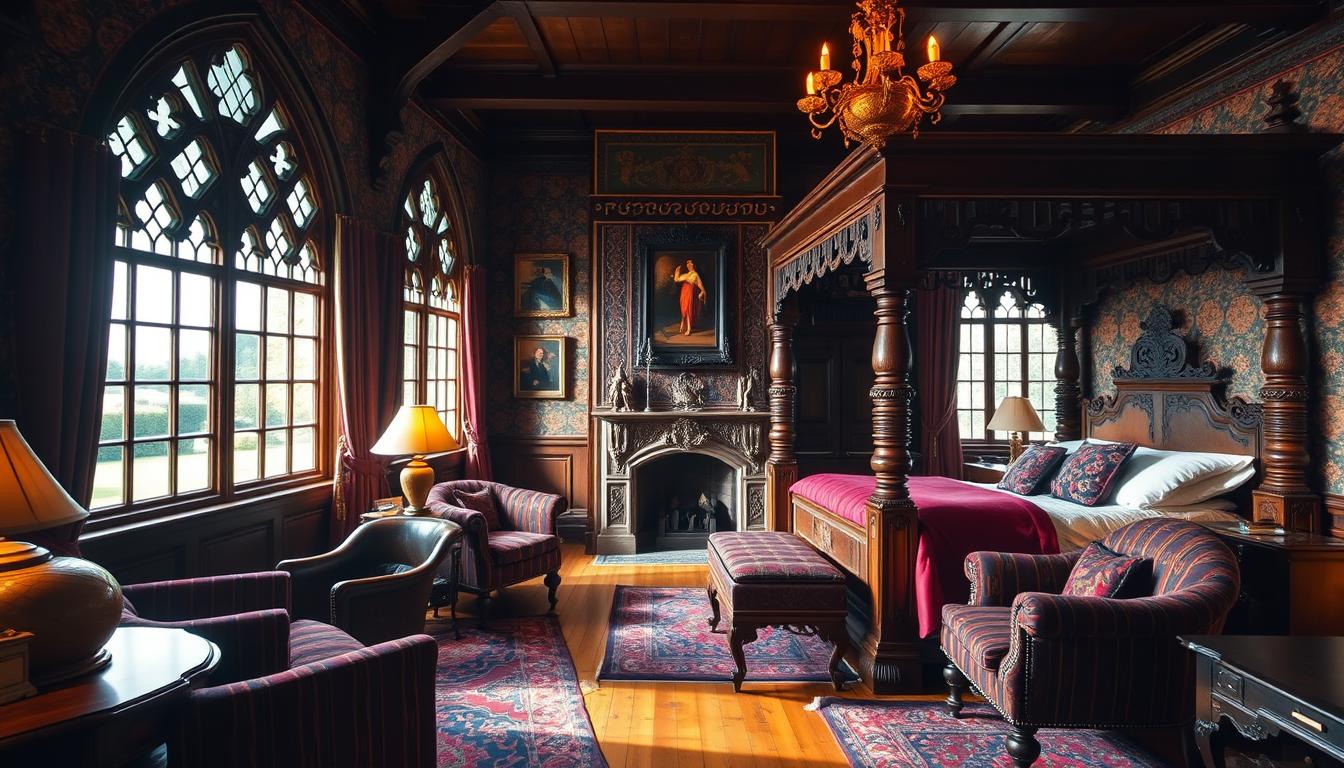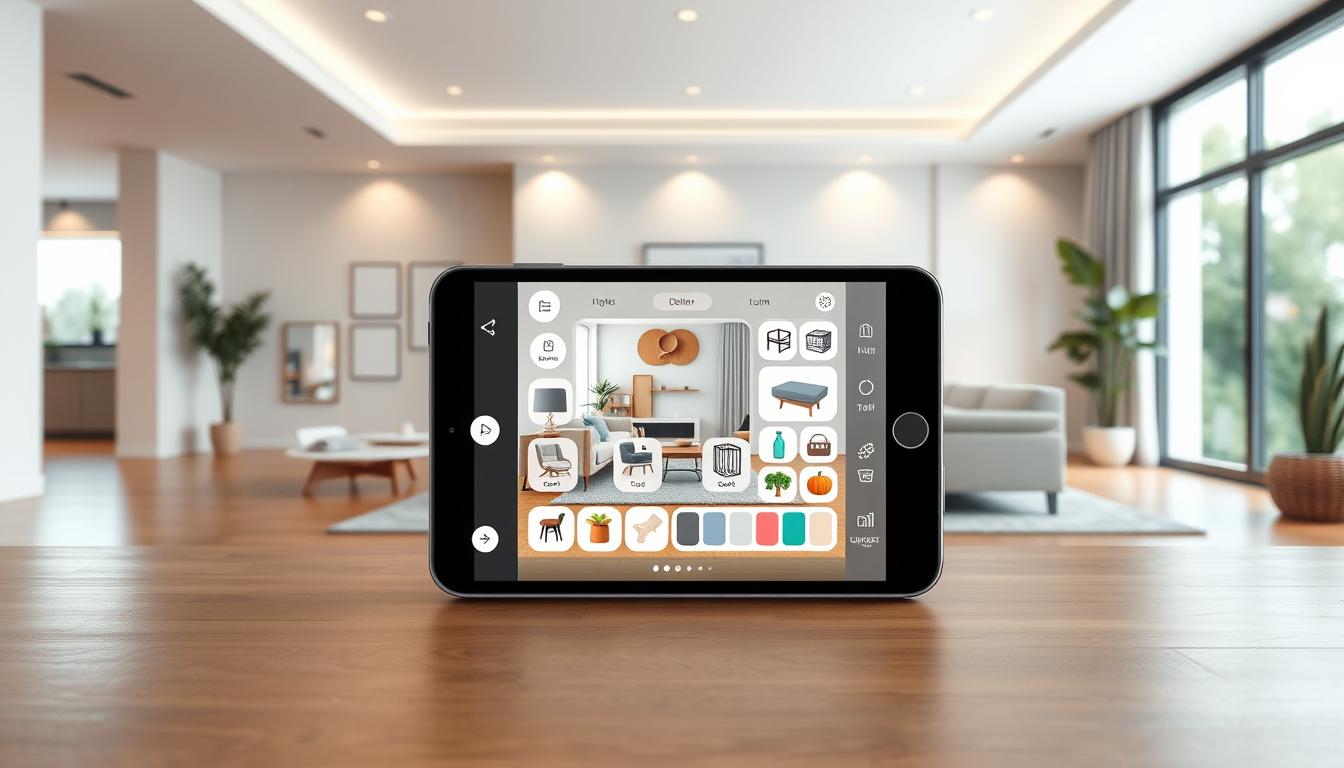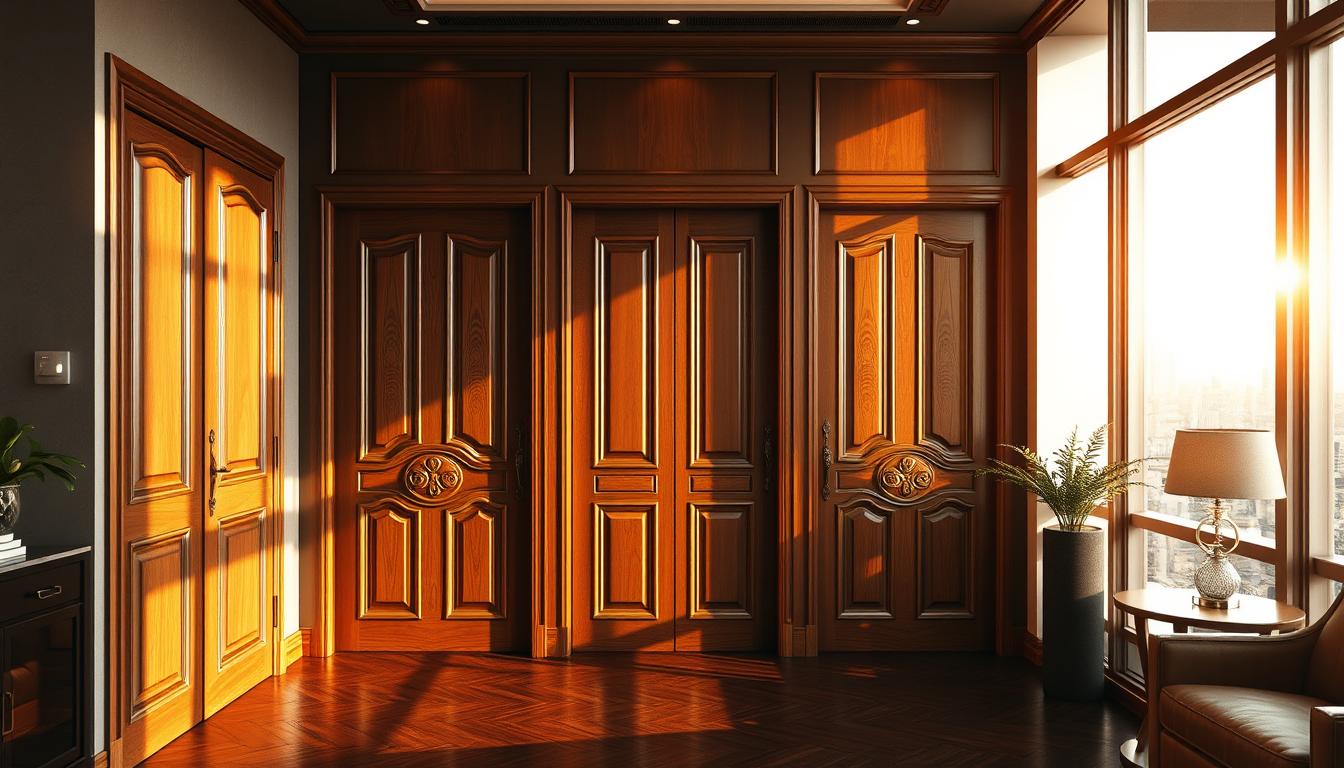The Tudor style has been loved by design enthusiasts for centuries. It’s known for its ornate woodwork, cozy fireplaces, and classic paneling. These features bring a sense of warmth and tradition to any home.
To add this timeless elegance to your home, we’ll look at the key elements. We’ll cover how to pick the right furniture and add period-specific details.
Key Takeaways
- Understand the historical context of Tudor architecture
- Choose furniture with classic, ornate details
- Incorporate period-specific accessories and decor
- Use warm, rich colors to create a cozy atmosphere
- Balance traditional elements with modern touches
Understanding Tudor Architecture and Design
To make a Tudor-inspired home interior, knowing Tudor architecture is key. Tudor homes come from 16th-century England. They have unique features and a rich history.
Key Features of Tudor Homes
Tudor homes stand out with their steep roofs, tall chimneys, and detailed designs. These elements shape both the look outside and inside. For example, exposed beams and wooden paneling add warmth and character.
The interior of Tudor homes often uses local materials and skilled craftsmanship. This shows the style’s historical roots. Key features include:
- Use of wooden beams and paneling
- Ornate detailing and carvings
- Incorporation of stone or brick accents
- Cozy, intimate spaces with rich textiles
| Feature | Description | Influence on Interior |
|---|---|---|
| Steeply Pitched Roofs | Characteristic of Tudor homes, adding to their distinctive silhouette | Influences the use of vaulted ceilings and exposed rafters indoors |
| Tall Chimneys | A prominent exterior feature, often ornate and decorative | Can be mirrored indoors with statement fireplaces and chimney breasts |
| Ornate Detailing | Includes intricate wood carvings and moldings | Adds depth and character to interior spaces through similar detailing |
Historical Context and Influence
The Tudor style was shaped by medieval architecture and the culture of its time. Knowing this history helps us appreciate Tudor home design. Local materials and traditional craftsmanship were key in shaping the style.
By embracing these historical influences, you can create a Tudor-inspired home interior. Use wooden accents, stone fireplaces, and rich textiles to capture the Tudor style’s essence.
Color Palette: Embracing Earthy Tones
Creating a Tudor-inspired home interior starts with embracing earthy tones. These colors bring warmth and authenticity to your space. The Tudor style is known for its rich, natural hues.
When picking colors for your Tudor home, think about history and nature. Earthy tones like oak, walnut, and stone are key. They add warmth and coziness to your home.
Popular Color Combinations
Tudor interiors often use rich, muted colors. These colors work well together. Here are some favorites:
- Warm oak with deep, rich greens
- Muted stone with walnut accents
- Earthy reds and browns for warmth and comfort
These colors reflect Tudor construction and make your home welcoming. For tudor home interior inspiration, try these traditional colors.
Tips for Choosing the Right Shades
Choosing the right colors for your Tudor interior is important. Think about your home’s lighting, furniture, and the look you want. Here are some tips:
- Think about your home’s natural lighting and how it affects colors.
- Choose colors that match your furniture and fixtures, like wood beams or stone fireplaces.
- Mix different shades and textures for depth and interest.
By picking the right colors and following tudor interior design trends, you can make a tudor home interior that’s both authentic and inviting.
Materials and Textures for Authenticity
To make your home look like a Tudor house, focus on the right materials and textures. These elements are key to bringing the Tudor style to life. They make your home feel rich and inviting.
Wood: The Foundation of Tudor Interiors
Wood is essential in Tudor design, used for paneling, flooring, and furniture. It adds warmth and beauty to any room. Oak was a favorite during the Tudor era for its strength and grain.
To add character, use reclaimed or distressed wood. Wooden beams, whether for function or decoration, also enhance your design’s authenticity.
Stone and Brick Accents
Stone and brick are key in Tudor architecture, used for fireplaces, walls, and flooring. They bring a solid feel to a room, connecting it to medieval times.
Choose stone and brick with a natural, unfinished look for authenticity. This adds history and depth to your space.
Incorporating Textiles and Fabrics
Textiles and fabrics add warmth and depth to Tudor interiors. Rich materials like velvet, tapestry, and heavy linen were common. They were used for upholstery, curtains, and wall hangings.
For a true Tudor feel, pick fabrics with complex patterns and earthy tones. They make your space cozy and inviting, just like Tudor homes.
By mixing wood, stone, brick, and textiles, you can create a Tudor-inspired home. It will feel authentic and welcoming.
Furniture Selection: Classic and Cozy
To make your Tudor home welcoming, choose furniture that’s both useful and looks good. The right pieces can bring the Tudor style’s warmth and coziness to life.
Look for furniture that shows off the Tudor style’s traditional charm. Choose classic pieces with ornate details and comfy upholstery. High-quality materials like solid oak or walnut wood are key to Tudor design.
Types of Furniture to Consider
Some iconic furniture for a Tudor home includes:
- Ornate wooden chairs and benches
- Plush armchairs with intricate upholstery
- Heavy wooden tables with carved details
- Cozy sofas with rich, velvety fabrics
These pieces enhance your home’s look and offer comfort and function. For example, a carved wooden bench can be both a seat and a decor piece.
| Furniture Piece | Characteristics | Benefits |
|---|---|---|
| Ornate Wooden Chairs | Intricate carvings, solid wood construction | Adds elegance, provides comfortable seating |
| Plush Armchairs | Rich upholstery, comfortable design | Creates cozy reading nooks, enhances room ambiance |
| Heavy Wooden Tables | Carved details, sturdy construction | Serves as a functional dining or coffee table, adds rustic charm |
Arranging for Functionality and Aesthetics
After picking the right furniture, arrange it to mix function and beauty. Think about your room’s layout and each space’s purpose. For example, in a living room, arrange seats for talking while also making it cozy.
“The arrangement of furniture in a room can greatly impact its overall ambiance. A well-balanced arrangement can make a room feel welcoming and harmonious.”
To get a harmonious layout, start with the room’s focal point, like a fireplace. Then, place other furniture around it for a unified look. Make sure there’s enough space for easy movement.
By picking and arranging furniture wisely, you can make a Tudor-inspired home that’s both classic and cozy. It will show off the timeless charm of this beloved style.
Creating a Warm Ambiance with Lighting
A well-designed lighting scheme can turn your home into a Tudor-style haven. It’s full of character and charm. Lighting makes your interior look cozy and inviting.
In Tudor homes, lighting is more than just light. It’s about creating an atmosphere that shows the style’s rich history and warmth. We need to think about the types of lighting fixtures and how to use natural light.
Types of Lighting Fixtures
Tudor interiors often have lighting fixtures that remind us of the past. These include candelabras, lanterns, and chandeliers with a medieval look. These fixtures light up the space and add to the decor.
- Candelabras: Adding elegance and historical touch.
- Lanterns: Giving warm, soft light that feels traditional.
- Chandeliers: Often with intricate designs that show Tudor craftsmanship.
When picking lighting fixtures, choose pieces that fit the Tudor style and meet your needs. For example, a beautiful chandelier can be a dining room centerpiece. Table lamps with candelabra-style shades can warm up living areas.
Using Natural Light to Our Advantage
Natural light is key in any home, and Tudor homes are no exception. They have large windows with multiple panes. These allow plenty of natural light to enter.
To make the most of natural light, try these tips:
- Keep windows clear of heavy drapery or furniture.
- Use light-colored window treatments to control light levels.
- Place mirrors opposite windows to reflect light into the room.
| Lighting Element | Purpose | Tudor Style Tip |
|---|---|---|
| Candelabras | Ambient Lighting | Choose candelabras with ornate details. |
| Lanterns | Accent Lighting | Hang lanterns in entryways or corridors. |
| Chandeliers | Main Lighting Source | Opt for chandeliers with medieval-inspired designs. |
By mixing these lighting elements and strategies, you can create a warm and inviting Tudor-inspired home. It honors the style’s heritage while meeting today’s needs.
“The right lighting can make a room feel cozy and welcoming, much like the warmth of a Tudor fireplace on a cold winter’s night.”
Architectural Details: Adding Character
Exploring Tudor-inspired interiors shows us how key architectural details are. They not only add character but also bring history and authenticity to our homes.
Exposed Beams and Mouldings are key in Tudor architecture. Exposed beams give Tudor homes their cozy, rustic feel. To add this to your home, use wooden beams that look like traditional timber.
Exposed Beams and Mouldings
The wood and craftsmanship of exposed beams greatly affect the look. Oak and chestnut are favorites for their durability and texture. Mouldings add sophistication and can frame doors, windows, and ceilings.
“The use of exposed beams and mouldings in Tudor homes creates a sense of warmth and coziness, making the space feel more inviting.” – Interior Design Expert
“The incorporation of wooden beams and intricate mouldings not only pays homage to the traditional Tudor style but also adds a layer of depth and character to the interior.”
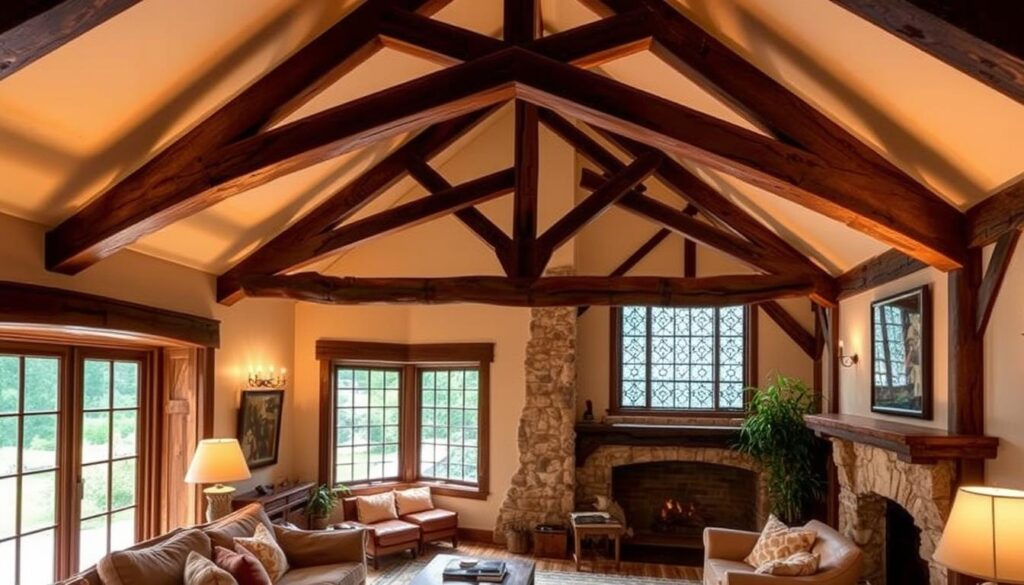
Decorative Fireplaces and Hearths
Decorative fireplaces and hearths are key Tudor design features. They are focal points and places for family and friends to gather. For an authentic look, use stone or brick in your fireplace design.
Think about materials and textures that fit your Tudor-inspired interior. For example, a stone fireplace with wooden mouldings creates a beautiful contrast.
- Choose materials that are consistent with the Tudor style, such as stone, brick, and wood.
- Consider the scale of your fireplace in relation to the room to ensure it doesn’t overwhelm the space.
- Incorporate decorative elements like carved wooden mantels or intricate stonework to add visual interest.
By carefully adding these architectural details, we can make our homes feel authentic and welcoming. Elements like exposed beams, decorative mouldings, and stunning fireplaces add character to our interiors.
Designing Cozy Living Spaces
A well-designed Tudor home interior is cozy and inviting. We focus on making spaces that are both functional and warm. This reflects the traditional charm of the Tudor style.
When designing cozy living spaces, furniture arrangement is key. We aim for a balance between comfort and style. This makes the space welcoming without losing its aesthetic appeal.
Choosing Furniture Arrangement
The key to a cozy living room is its furniture arrangement. Start with a statement piece, like a plush sectional sofa. Then, arrange other furniture around it to create conversational circles.
- Place the largest furniture pieces, like sofas and armchairs, in a way that they face each other, encouraging interaction.
- Use smaller furniture items, such as ottomans and coffee tables, to fill in the gaps and add functionality.
- Consider the traffic flow and ensure there’s enough space to move around comfortably.
To add a Tudor feel, include traditional furniture pieces. Wooden benches or intricately carved armchairs work well.
Creating Nooks with Purpose
Nooks are key in cozy living spaces. They provide areas for relaxation, reading, or enjoying a cup of coffee. We create nooks with purpose by:
- Selecting a comfortable chair or a chaise lounge and placing it in a quiet corner.
- Adding a floor lamp or a table lamp to provide warm, soft lighting.
- Incorporating decorative elements, such as throw blankets, pillows, and side tables, to enhance the coziness.
To add Tudor charm, consider built-in bookshelves or window seats in your nooks.
Let’s examine some common furniture arrangements and their characteristics in the table below:
| Furniture Arrangement | Characteristics | Ideal for Tudor Homes |
|---|---|---|
| Conversational Circle | Encourages interaction, cozy | Yes |
| Floating Furniture | Creates space, modern feel | No |
| Symmetrical Layout | Balanced, traditional | Yes |
By carefully arranging furniture and creating nooks, we can design cozy living spaces. These spaces embody the warmth and charm of the Tudor style.
Bringing the Outdoors In
To truly capture the essence of Tudor style, we must consider how to integrate the outdoors into our interior design. The Tudor style is characterized by its connection to nature. By bringing elements of the outdoors in, we can create a more authentic and inviting space.
Garden and Landscape Influences
The gardens and landscapes surrounding Tudor homes are often lush and verdant. They feature a mix of native plants and flowers. To bring this outdoorsy feel into our homes, we can incorporate elements such as:
- Natural materials like wood and stone
- Earth-toned color palettes
- Floral patterns and botanical prints
By incorporating these elements, we can create a seamless transition between indoors and outdoors. This reflects the charm of the Tudor style.
Incorporating Nature Through Windows
Windows play a crucial role in connecting our indoor spaces to the outdoors. In Tudor homes, windows are often designed to provide expansive views of the surrounding landscape. To achieve this in our own homes, we can:
| Window Treatment | Description | Benefit |
|---|---|---|
| Minimalist drapes | Simple, unobtrusive drapes that don’t obstruct the view | Preserves the natural light and view |
| Large panes | Windows with large panes to maximize the view | Creates a sense of connection to the outdoors |
| Skylights | Skylights that bring in natural light from above | Enhances the sense of openness and brightness |
By thoughtfully designing our windows and window treatments, we can strengthen the connection between our indoor spaces and the natural beauty outside. This further enhances the Tudor charm of our homes.
Crafting the Perfect Kitchen
Creating a Tudor-style kitchen is about mixing classic looks with today’s needs. It’s more than just looks; it’s a warm, functional space at the heart of the home.
To get it right, knowing the key Tudor kitchen elements is crucial. Traditional cabinetry with fancy details like carvings and mouldings is key to Tudor design.
Tudor-Style Kitchen Essentials
A Tudor kitchen stands out with its traditional materials and focus on details. Key elements include:
- Wooden Cabinets: Made from oak or other hardwoods, these cabinets have detailed carvings and fancy hardware.
- Stone or Brick Fireplaces: These fireplaces are central, adding warmth and charm.
- Exposed Beams: Whether for structure or decoration, these beams create a cozy, rustic feel.
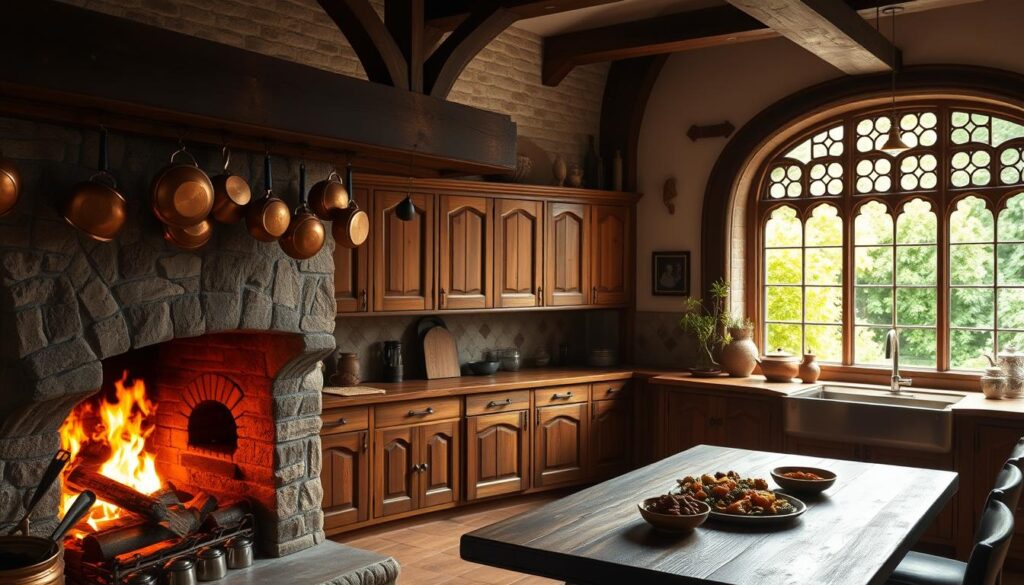
Layout Ideas for Functionality
A good kitchen layout is vital for use. In a Tudor kitchen, mix traditional looks with modern needs. Think about a layout with:
- A Central Island: It adds counter space and storage, and’s a great spot for gathering.
- Efficient Workflow: Make sure the kitchen’s layout helps with cooking, prep, and cleaning.
- Ample Storage: Use traditional cabinets with modern storage to keep things tidy.
With these elements and layout tips, you can make a Tudor-inspired kitchen that’s both stunning and practical. It will show off the Tudor style’s warmth and charm.
Bathroom Inspirations: Elegant and Timeless
The Tudor style is perfect for bathroom design, blending luxury with heritage. To create a bathroom that feels like the Tudor era, focus on a few key elements.
Features of a Tudor Bathroom
A Tudor bathroom uses traditional materials and ornate details. Ornate fixtures and rich textiles are key to its look. Think about adding:
- Freestanding tubs with claw-foot designs
- Wall-mounted sinks with ornate faucets
- Intricately designed mirrors and lighting fixtures
These features honor the Tudor style and make the bathroom sophisticated.
Choosing Fixtures and Accessories
When picking fixtures and accessories, choose items that show Tudor craftsmanship. Look for:
| Fixture/Accessory | Tudor Style Characteristics |
|---|---|
| Faucets and Fixtures | Ornate designs, brass or bronze finishes |
| Lighting | Candelabra-style fixtures, metalwork |
| Mirrors | Ornate frames, beveled edges |
With these elements, your bathroom will be elegant, timeless, and deeply Tudor.
Finishing Touches: Accessories and Decor
As we finish our Tudor-inspired home, we need to think about accessories and decor. The right items can make our home feel real and welcoming. It’s all about the details.
Choosing art and decor should match the Tudor style. Look for items that reflect the era, like antique furniture or traditional Tudor artwork. Consider medieval-inspired tapestries or classical portraits to add depth and character.
Selecting Art and Decorative Pieces
When picking art and decor, think about the color palette and style we want. Tudor style often uses earthy tones, rich textures, and classic motifs. Look for pieces with natural materials like wood, stone, or metal to add warmth.
Some great decorative pieces include:
- Antique or reproduction Tudor-style furniture
- Traditional tapestries or textiles
- Classical artwork or portraits
- Natural elements like branches or stone
Incorporating Personal Touches
Adding personal touches is key to making our Tudor-inspired home unique. Displaying family heirlooms, personal treasures, or meaningful objects can tell our story. By blending these personal elements with Tudor decor, we create a space that reflects our personality.
As the renowned interior designer,
“The key to great interior design is to make it personal, to tell a story, and to create a sense of warmth and welcome.”
By adding personal touches and meaningful objects, we can make our Tudor-inspired home a reflection of our story.
By carefully choosing art and decorative pieces and adding personal touches, we can finish our Tudor-inspired home interior. We create a space that is both beautiful and meaningful.
Maintaining Your Tudor Home Interior
Keeping your Tudor home looking great takes work. You need to keep it up regularly. This way, your Tudor home will stay beautiful for a long time.
Preservation Techniques
For your Tudor home, clean it often and check for damage. Fixing small problems early can save you from big repairs later. Also, sticking to Tudor design trends will keep your home looking its best.
Professional Assistance
If you need big changes or repairs, get help from experts. They know how to update your home without losing its Tudor charm. This way, your home will stay true to its original beauty.

